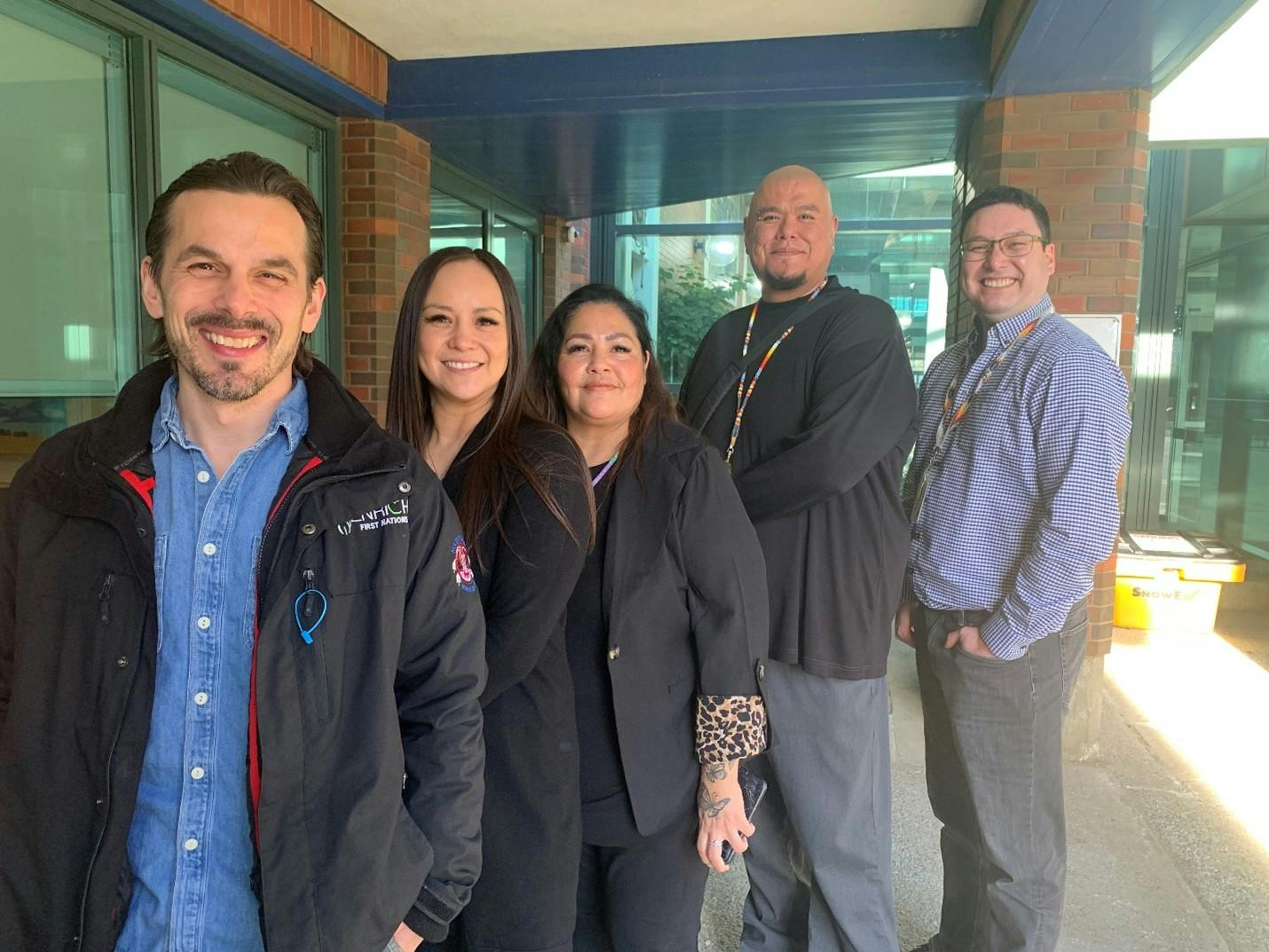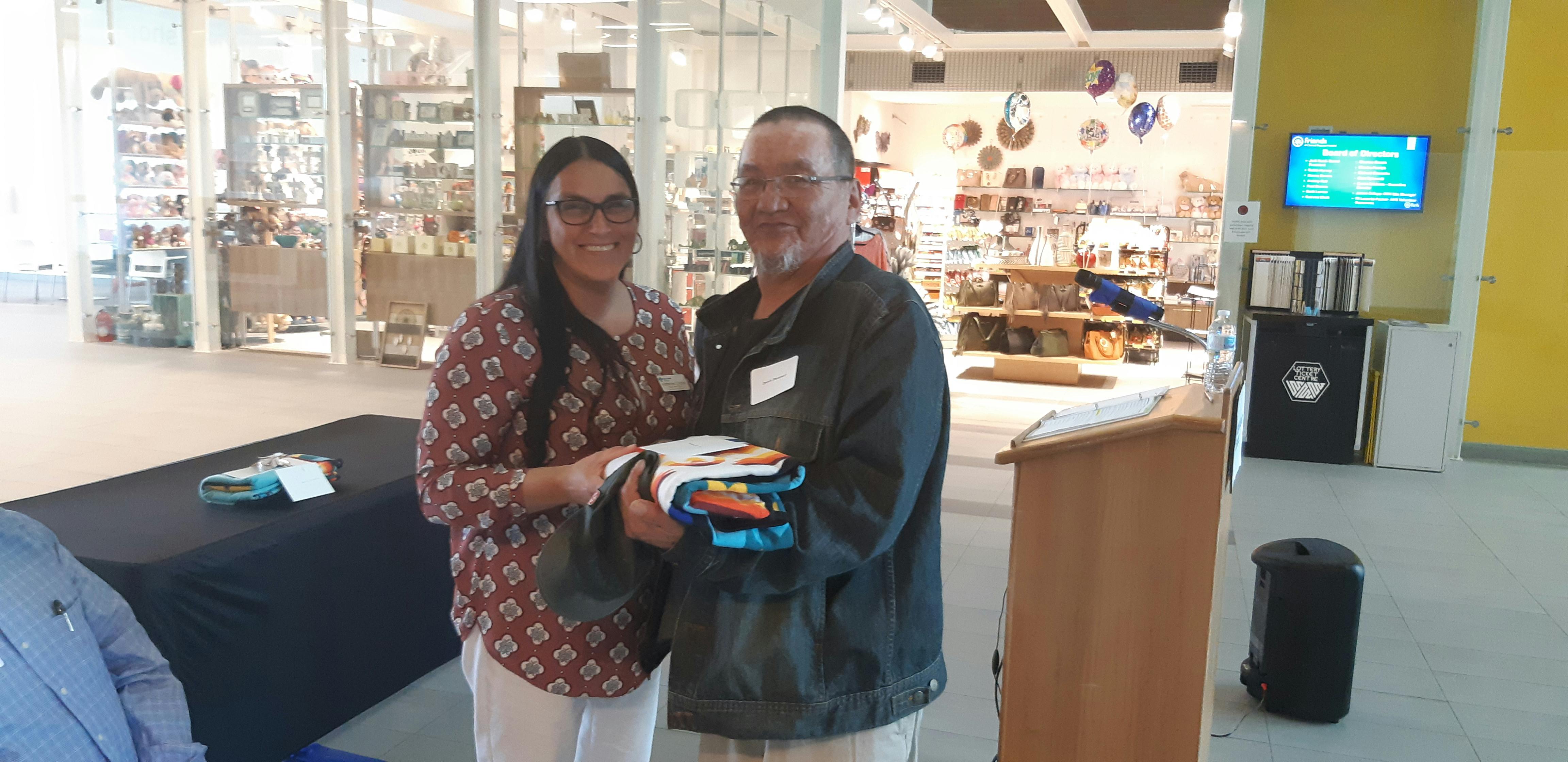Four Winds Initiative
This project has now concluded.
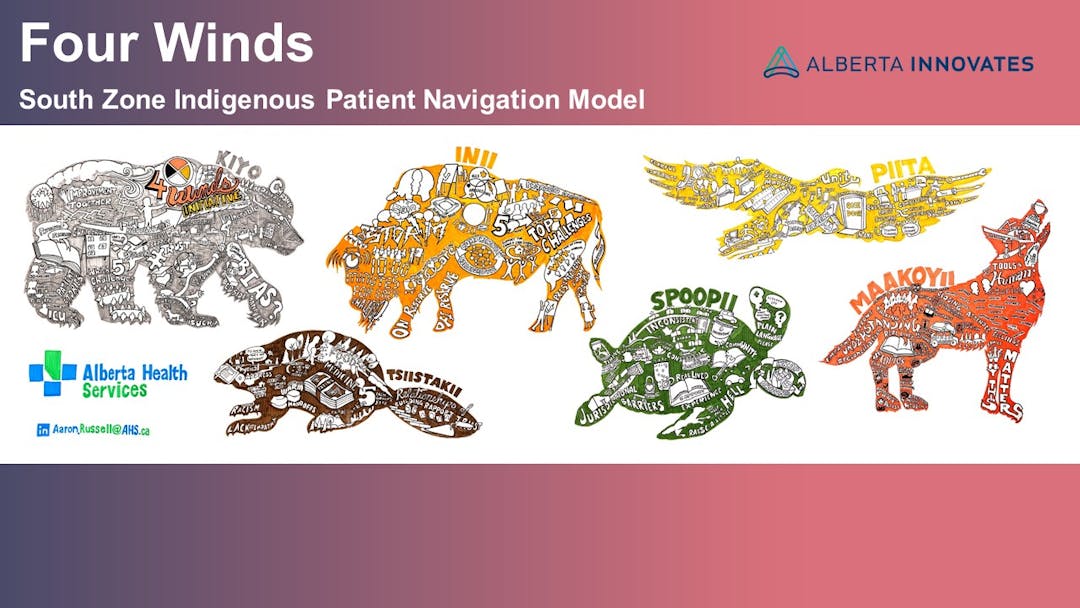
The Partnership for Research and Innovation in the Health System (PRIHS) Indigenous Patient Navigator project has the goal of helping Indigenous Patients and their families to navigate the complexities of the health system and to help them through the different transitions during their journey in and out of care. We know Indigenous people continue to experience barriers in accessing health care leading to health inequities and poor health outcomes compared to other segments of the population.
This project will work with Indigenous patients and families to co-design a navigation service with the goals of providing smoother access to services, creating better connections to health and other community services, and ultimately improving health outcomes.
To learn more or to access Four Winds Indigenous Patient Navigation services, please contact us:
| Kara Eagle Bear, Indigenous Patient Navigator | T: (403) 634-0939 | |
| Jeremy Chief Calf, Indigenous Patient Navigator | T: (403) 634-0930 | |
| Program Email: fourwinds@ahs.ca |
The Partnership for Research and Innovation in the Health System (PRIHS) Indigenous Patient Navigator project has the goal of helping Indigenous Patients and their families to navigate the complexities of the health system and to help them through the different transitions during their journey in and out of care. We know Indigenous people continue to experience barriers in accessing health care leading to health inequities and poor health outcomes compared to other segments of the population.
This project will work with Indigenous patients and families to co-design a navigation service with the goals of providing smoother access to services, creating better connections to health and other community services, and ultimately improving health outcomes.
To learn more or to access Four Winds Indigenous Patient Navigation services, please contact us:
| Kara Eagle Bear, Indigenous Patient Navigator | T: (403) 634-0939 | |
| Jeremy Chief Calf, Indigenous Patient Navigator | T: (403) 634-0930 | |
| Program Email: fourwinds@ahs.ca |
This project has now concluded.
-
Indigenous Patient Navigation brochure
Share Indigenous Patient Navigation brochure on Facebook Share Indigenous Patient Navigation brochure on Twitter Share Indigenous Patient Navigation brochure on Linkedin Email Indigenous Patient Navigation brochure linkTake a look at our brochure to learn more about accessing Indigenous Patient Navigation supports.
-
Meet our team - Leslie Wells
Share Meet our team - Leslie Wells on Facebook Share Meet our team - Leslie Wells on Twitter Share Meet our team - Leslie Wells on Linkedin Email Meet our team - Leslie Wells link
Leslie Wells wants to help. It’s who she is.
The drive to be there for others is why she chose a career with the Blood Tribe’s Bringing the Spirit Home program offering clients support in their struggles with addiction, and later made the move to AHS as Senior Project Manager for the Four Winds Project within the Indigenous Wellness Core.
“Bringing the Spirit Home was such a rewarding place to work, but it can be really hard on you and it takes a toll,” explained Wells. She was also saddened to hear stories from Indigenous clients of their challenges accessing healthcare – whether at emergency departments or clinics.
“Around that time, I saw this job opportunity,” Wells continued. “I needed a change, and what better way of representing and helping my people than to join an organization like AHS.”
In her role, which she started in April of 2022, Wells has played an important part in growing relations between South Zone leadership and the Blood Tribe and Piikani Nations, between staff and patients, and in building the Indigenous Patient Navigator (IPN) model that launched last year.
The South Zone’s two IPNs, Kara Eagle Bear and Jeremy Chief Calf, are available to help Indigenous patients and their families navigate the complexities of the health system and guide them through their journey in and out of care. The goal is to break down barriers Indigenous patients experience in accessing healthcare – barriers that lead to health inequities and poor health outcomes compared with other segments of the population.
The early success of the navigators is evident as Wells shares feedback she’s received from patients that includes quotes like “I felt safe and supported” and “I felt like my voice was being heard.”
“I don’t want to take credit for this because it’s the navigators that do all the work,” Wells quickly adds, also acknowledging Elders who have provided guidance. “My job is to be their support system and make sure they have what they need to succeed.”
While the progress is heartening, breaking down the systemic issues Indigenous peoples face in healthcare is no easy task and there are still hard days.
“Along with my full-time work and being a full-time mother, I just finished my Master of Social Work,” says Wells. “It’s not a bad stress because I’m bettering my life, but I still need to take time for self-reflection and self-care. I meditate, go for long walks to rejuvenate my soul. We’re a rodeo family and I love to watch my daughter barrel race. It all helps.”
As for the work that lays ahead, Wells sees a clear path forward.
“We need to keep building bridges between Indigenous and non-Indigenous peoples, because that’s how we’re going to function as a world. By building meaningful relationships, we’ll all be better and stronger.”
-
Update on the Indigenous Patient Navigator Project
Share Update on the Indigenous Patient Navigator Project on Facebook Share Update on the Indigenous Patient Navigator Project on Twitter Share Update on the Indigenous Patient Navigator Project on Linkedin Email Update on the Indigenous Patient Navigator Project linkSince the Indigenous Patient Navigator (IPN) project launched last year, many patients and families have benefitted from the service. To coincide with National Indigenous Peoples Awareness Month in June, we’re happy to raise awareness about this valuable service in the South Zone and offer a reminder about how to access it.
The IPNs, Kara Eagle Bear and Jeremy Chief Calf, are available to help Indigenous patients and their families navigate the complexities of the health system and guide them through the different transitions during their journey in and out of care. These roles were created to break down barriers Indigenous patients experience in accessing health care – barriers that lead to health inequities and poor health outcomes compared with other segments of the population.
Feedback has been positive and heartening, reaffirming that the Indigenous Wellness Core is on the right track. We’d like to share an excerpt from one letter, received recently from a patient’s family member.
“Kara Eagle Bear has been our family's saving grace… My siblings and I have three loved ones in our immediate family that struggle with addictions… Her kindness, her patience, and understanding are remarkable. She opens her heart to people that are addicted. When you are in this field of work you have to have true and honest compassion… You have to care for people just as you care for your own family. Kara was all of this and so much more… She made the process run smoothly and easy, she got right to work finding all different options to help us as a family… I am happy to say we have one sober/clean family member from addictions and we are working on the other two. I hope to see many more people like Kara in this field. It would help substantially with the fight against this opioid crisis.”
In this, a patient shares their appreciation for the support they’ve received from Chief Calf.
"I really appreciated the support the Indigenous Patient Navigator provided to me. He was very helpful in making me aware of options and made sure I was able to go to a safe place. I felt listened to and supported. I am happy that the Indigenous Patient Navigator Program exists."
Since the IPN project began, more than 300 patients and their family members have received smoother access to services. Navigators serve in-patients and out-patients across the South Zone at Chinook Regional Hospital in Lethbridge, Medicine Hat Regional Hospital, Cardston Health Centre, Pincher Creek Health Centre, Fort Macleod Health Centre, as well as on the Blood Tribe and Piikani Nation First Nations.
IPNs support Indigenous patients with:
- Pre-admission to access health-related programs and support continuity of care
- Emergency or hospital admission to assist the healthcare team to provide medical translation of the diagnosis and hospital process
- Inpatient stays to provide support, medical translation and education to patients and families with culturally safe supports
- Discharge to assist Indigenous patients navigate services and programs between hospital and community
To connect directly with the Four Winds team, Indigenous patients or their family members are encouraged to visit together4health.ahs.ca/four-winds or ask a healthcare worker for assistance.
Sincerely,
Richard Oster – Scientific Director/Principal Investigator
Kienan Williams – Innovation & Research Team Lead
Leslie Wells – Senior Project Manager
Kara Eagle Bear – Indigenous Patient Navigator
Jeremy Chief Calf – Indigenous Patient Navigator -
Indigenous support line launches across southern Alberta
Share Indigenous support line launches across southern Alberta on Facebook Share Indigenous support line launches across southern Alberta on Twitter Share Indigenous support line launches across southern Alberta on Linkedin Email Indigenous support line launches across southern Alberta link
We are pleased to share that Indigenous Peoples in the South Zone of Alberta Health Services (AHS) how have additional resources available to help them navigate the health system.
The toll-free Indigenous Support Line was expanded to the South Zone on May 1, and can be reached by calling 1-844-944 4744.
The support line is staffed by Indigenous Health Link staff, who will answer callers’ questions, help them access culturally appropriate care and support and assist them with navigating the healthcare system. The line is available weekdays from noon to 8 p.m. Clients can call at any point in their healthcare journey with questions or concerns – whether or not they are currently receiving care, about to start care, in care, or have been discharged from care.
Click here to learn more about the Indigenous Support Line (1-844-944-4744).
-
Indigenous-led Patient Navigation service re-launched
Share Indigenous-led Patient Navigation service re-launched on Facebook Share Indigenous-led Patient Navigation service re-launched on Twitter Share Indigenous-led Patient Navigation service re-launched on Linkedin Email Indigenous-led Patient Navigation service re-launched link
South Zone project helps to identify and remove obstacles to accessing healthcare
LETHBRIDGE – Indigenous Peoples can contact the Four Winds South Zone Project to support navigation and coordination of access to Alberta Health Services (AHS) through the Indigenous Patient Navigators (IPN). This service has returned after being put on hiatus to respond to pandemic health needs.
The role of the IPN is to work with Indigenous patients alongside clinical teams to promote health equity for Indigenous Peoples in southern Alberta. Navigators work alongside the Indigenous Hospital Liaison Services | Alberta Health Services and Traditional Wellness Coordinator Services | Alberta Health Services currently offered by the Indigenous Wellness Core in the South Zone.
Our IPNs support Indigenous patients with:
- Pre-admission to access health-related programs and support continuity of care.
- Emergency or hospital admission to assist the healthcare team to provide medical translation of the diagnosis and hospital process.
- Inpatient stays to provide support, medical translation and education to patients and families with culturally safe supports.
- Discharge to assist Indigenous patients navigates services and programs between hospital and community.
The IPN service offered through Four Winds is available at: Chinook Regional Hospital in Lethbridge, Cardston Health Centre, Pincher Creek Health Centre and Fort Macleod Health Centre.
The service is unique as Indigenous patients, or their family members, can contact the Four Winds team directly. To ensure the support of as many Indigenous patients as possible, clinicians and healthcare providers can also contact the Four Winds team and refer Indigenous patients to the service.
The Four Winds team are members of Kainai, Piikani and Sandy Lake (ON) First Nations.
The Indigenous Patient Navigators are Kara Eagle Bear (Tanataaki) and Jeremy Chief Calf. They join Senior Project Manager Leslie Wells (Maahstoohkoomii), all three are members of the Kainai Nation (Blood Tribe). While Eagle Bear is also a member of the Piikani Nation. Together they bring to their roles extensive combined career experience in healthcare, addiction and mental health services, the justice system, along with child and family social services.
Eagle Bear and Chief Calf Both are excited to help create and strengthen relationships with patients and staff and look forward to making a positive difference for Indigenous Peoples navigating the health system.
"I am grateful to be working alongside a great Indigenous team and helping patients in and out of the hospital,” says Chief Calf. “We have received great appreciation from patients and staff for the program.”
Eagle Bear says she too is grateful to help her people navigate through the healthcare system and feels good knowing she is making a difference in someone’s health and well-being.
-
AHS launches navigation service for Indigenous Peoples
Share AHS launches navigation service for Indigenous Peoples on Facebook Share AHS launches navigation service for Indigenous Peoples on Twitter Share AHS launches navigation service for Indigenous Peoples on Linkedin Email AHS launches navigation service for Indigenous Peoples linkLETHBRIDGE – Indigenous Peoples in the South Zone of Alberta Health Services (AHS) can now receive one-on-one help to access the health services they need with the launch of a new Indigenous Patient Navigation service.
The service aims to improve patient outcomes for Indigenous Peoples, and address health inequities between Indigenous and non-Indigenous populations. For instance, research shows life expectancy for First Nations in Alberta is 10 years shorter than non-First Nations.
“It is essential Indigenous Albertans have access to the healthcare services and medical information they need,” says Tyler Shandro, Minister of Health. “Providing navigation services will better support Indigenous patients and their families, and is an important step to improving health outcomes for Indigenous Albertans.”The service has hired a full-time Indigenous patient navigator, Chloe Crosschild, a registered nurse and a member of the Blood Tribe (Kainai).
“My own experiences fuel my passion to close the health equity gap for Indigenous Peoples in the South Zone,” says Crosschild, who is based out of Chinook Regional Hospital in Lethbridge but serves the entire zone. “This position will better assist Indigenous Peoples to navigate the complex array of programs and services AHS has to offer. In doing so, my hope is that Indigenous Peoples will experience positive and meaningful encounters with the healthcare system.”
During AHS community engagement sessions held a year ago, many Indigenous patients and families in the South Zone expressed frustration they were both unaware of and overwhelmed by the range of health services that AHS offers. In response, AHS and Indigenous stakeholders co-designed the navigation service, which is supported by $1.4 million in grant funding from the Partnership for Research and Innovation in the Health System (PRIHS), a partnership between AHS and Alberta Innovates.
“No one can speak to the challenges faced by Indigenous Peoples in Alberta better than they can themselves,” says Dr. Katherine Chubbs, Chief Zone Officer for AHS South Zone. “Participants in our engagement sessions identified that a patient navigation service could address some of those challenges.”
Dr. Melissa Potestio, Scientific Director for AHS’ Population, Public and Indigenous Health Strategic Clinical Network, says the project builds on the trust and strong working relationships the South Zone has maintained with Indigenous communities through ongoing engagement with the departments of health on the Kainai and Piikani First Nations, and the urban Indigenous population.
“This is not just a new service,” says Dr. Potestio, who is co-leading the project with Chubbs. “This is a robust, three-year research project that will examine the effectiveness of co-designing a navigation model, the impact on health outcomes and inequities, and how the model could be adapted for other jurisdictions.”
The project also involves:- Developing an Indigenous Patient Passport to help patients with their plan of care between home, the doctor’s office, outpatient clinics and the hospital.
- Compiling community and clinic profiles that identify the health services and supports available (on and off reserve) to help with discharge planning and ensure continuity of care.
- Co-designing a medical body chart translated into Blackfoot, as well as a Cultural Practices Guide to provide a resource for healthcare providers to identify common clinical practices from an Indigenous cultural perspective and offer tips for connection to provide culturally safe care.
Throughout the project, the team will be seeking feedback from patients, providers and various stakeholders to ensure ongoing improvements can be implemented and evaluated, all in an effort to ensure the service is improving the experience and health outcomes for Indigenous Peoples.
-
Get to Know the South Zone Indigenous Patient Navigator
Share Get to Know the South Zone Indigenous Patient Navigator on Facebook Share Get to Know the South Zone Indigenous Patient Navigator on Twitter Share Get to Know the South Zone Indigenous Patient Navigator on Linkedin Email Get to Know the South Zone Indigenous Patient Navigator linkCLOSED: This discussion has concluded.Oki, niitaniko Iitaapiit'saanskiaki!
- Tell us a little about yourself, your background
Hello, my name is Chloe Crosschild. I am a member of the Blackfoot Confederacy from the Blood Tribe (Kainai Nation) with relations from both Mamioyiiski (Fish Eaters) and Aakaipokaiksi (Many Children) Clans.
I was raised both on and off reserve by my parents who have been married for nearly thirty years. I am the eldest of five children and single mother to my nine-year-old daughter, Paisley. I currently follow Siksikaitsitapi (Blackfoot ways of knowing) and honor Naatowa'pii (holy way of life).
I am also a Registered Nurse with a Bachelor and Master degree in Nursing from the University of Lethbridge currently working toward my PhD in Nursing. As an RN, I have worked as a community and public health nurse for AHS and the Blood Tribe Department of Health and as a Clinical Instructor and Advisor to the Nursing Curriculum for the University of Lethbridge. As a PhD student, I have also worked with the EQUIP Emergency research project while attending school at the University of British Columbia.
2.What are you most excited about in this position?This position is part of a larger research project that takes a grassroots approach to collaborate with Indigenous community members. As the Indigenous Patient Navigator, I will have the opportunity to listen, learn, and share solutions and strategies with First Nation, Metis, and Inuit peoples in the South Zone to address the current gaps in health programs and services. Moving away from the traditional top down approach to providing services, the Indigenous Patient Navigator position works with and alongside Indigenous Peoples to co-create solutions and that is what I am most excited about.
3.How do you hope this position will help Indigenous patients and families?I am passionate about Indigenous Peoples health and working to address health inequities Indigenous Peoples face. As a young Indigenous woman and RN, I have not only witnessed but experienced racism and discrimination in the health care system. These experiences fuel my passion to close the health equity gap and I believe that this position will be able to effectively bridge the gaps in health and health care for Indigenous Peoples in the South Zone. I hope this position will better assist Indigenous Peoples to navigate the often complex array of programs and services AHS has to offer. In doing so, my hope is that Indigenous Peoples in the South Zone will experience positive and meaningful encounters with the health care system.
4.Tell us about your research interestsOver the past three years I have been involved in health research, specifically in Indigenous Peoples' Health, maternal child health and structural violence. In August 2019, I successfully defended my MN thesis, Urban Indigenous Mothers' Experiences with Postnatal Nursing Care in Southern Alberta: A Blackfoot Methodology. My thesis was a community engaged project that centered Blackfoot values and protocols throughout the research process. Inspired by the mothers stories I believe it was imperative to continue with this research to advocate and push for health equity in southern Alberta. I am currently enrolled in the PhD in Nursing program at the University of British Columbia to expand on my thesis research.
5.What’s the one thing people would be surprised to know about you?It's very surprising for people to learn that there are five generations of women alive and well in my family. My daughter is still able to visit with her great-great grandmother and we see her on a weekly basis. I took my last position as the PHN in Cardston just so I could be closer to her.
6.What’s something you’re really grateful for?
I am truly grateful for the strong Indigenous women who raised me. My mother, grandmothers, and all my aunts have supported me in all avenues of my personal and professional journey. It is their strength and tenacity that has allowed me to be here and the intergenerational wisdom of my ancestors has guided me to where I am today.
7.How do you like to spend your free time?
I typically spend my free time with my family or reading a good book. Due to the COVID-19 quarantine, I have learned that I love virtual paint nights, puzzles and board games.
8.What is your favourite family vacation?
I have traveled many places with my family, including road trips down the west coast and through the Redwood Forest, to Disney Land in California, to Disney World in Florida, to Mexico, and most recently to Maui. Although, my favourite family vacation would have to be the two trips we've made to the Riviera Maya in Mexico. We spent a lot of our time unwinding and relaxing on the beach, swimming and snorkeling in turquoise waters, and ATVing and Ziplining through the jungle at night. The food was always great and the people are always so welcoming.
9.What are you most proud of?
I am most proud of my daughter, Paisley. She is the light of my life and keeps me on my toes. As a young and single mother, I told myself that I wouldn't become another statistic. I wanted my daughter to have a good life and be proud of where she came from. Four days after delivering my daughter, I was back in the classroom with a baby on my hip. We like to joke around and tell people that she also has her BN, MN and soon to have a PhD because of all the nights she's listened to me talk about my papers and presentations. Paisley's love of animals and art is inspiring to me. She has two horses, Ru and Buttercup, one dog, Nanook, and two cats, Gizmo and Oliver.
10.How do you maintain a healthy lifestyle?
I spend time with family and friends, cook homemade meals (most of the time), and take long walks in the coulees.
Photo Credit: University of Lethbridge
-
National Indigenous Peoples Day 2020
Share National Indigenous Peoples Day 2020 on Facebook Share National Indigenous Peoples Day 2020 on Twitter Share National Indigenous Peoples Day 2020 on Linkedin Email National Indigenous Peoples Day 2020 linkCLOSED: This discussion has concluded.We are thankful for the land on which we are able to work, live, and play and give thanks and acknowledgement to the traditional territory of the Blackfoot peoples and for the many First Nation, Métis, and Inuit who now call this place home.
We have included a list of suggestions on how to celebrate or commemorate this meaningful day:
Summer Solstice Indigenous Festival: Live-stream the virtual edition of the Summer Solstice Indigenous Festival from June 1 to 21
Spend the day learning about Indigenous history of where you live or work: A Timeline of Alberta’s Indigenous History; The Blackfoot Nation; Writing-on-Stone Sacred Roots
Learn some greetings in the language or where you live or work: USAY Blackfoot Learning Guide
Seek out podcasts by Indigenous peoples: Native Currents, This Land, Red Man Laughing, Coffee With My Ma, All My Relations, The Jig Is Up, Missing and Murdered: Finding Cleo
Seek out music by Indigenous musicians
Seek out Films and Documentaries: Reel Injun (trailer), Indigenous Made Film Catalogue; Shadow of Dumont (trailer), Rhymes for Young Ghouls, Blood Quantum, Smoke Signals, Stolen Spirits of Haida Gwaii, Thunderheart, Windtalkers
Read a book by an Indigenous author
Discover Indigenous Humour: CBC’s Unreserved devoted an episode to Indigenous comedy, Stand-up, sketch and satire: The rise of Indigenous comedy; Charlie Hill at the Winnipeg Comedy Fest; Don Burnstick
Fill your personal or professional pledge of Reconciliation and discuss with family, friends and colleagues
Read and discuss the 10 Guiding Principles of Reconciliation from the Truth and Reconciliation Commission Report with family and colleagues.
-
COVID-19
Share COVID-19 on Facebook Share COVID-19 on Twitter Share COVID-19 on Linkedin Email COVID-19 linkCLOSED: This discussion has concluded.Thank you for visiting Together4Health. We have paused our engagement activities on this project so that our AHS teams can focus on supporting Albertans as we work together to respond to COVID-19. We appreciate your understanding.
If you have questions about COVID-19, please visit www.alberta.ca/covid19 to learn more. Online resources include a self-assessment for COVID-19; complete that assessment before calling Health Link 811.
Please subscribe to this project to receive updates and be alerted when this project page is reactivated.
-
Four Winds Stakeholder Engagement Session
Share Four Winds Stakeholder Engagement Session on Facebook Share Four Winds Stakeholder Engagement Session on Twitter Share Four Winds Stakeholder Engagement Session on Linkedin Email Four Winds Stakeholder Engagement Session linkCLOSED: This discussion has concluded.The first stakeholder engagement session was held on September 10, 2019. Co-Investigators, Katherine Chubbs and Dr. Melissa Potestio led the participants through an energizing and collaborative day to discuss the challenges of Indigenous patient navigation.
Participants from the Kainai First Nation, Piikani First Nation, Métis and Inuit along with members from the community and staff from Alberta Health Services met to share and discuss challenges experienced by Indigenous peoples when accessing/navigating services within the South Zone of Alberta.

Groups prioritized the challenges and brainstormed potential solutions. The group participation and collaboration was a key part of the co-design process.

By the end of the day, 213 solutions were identified for 28 different challenges ranging from accessibility and access to primary health care to integration, collaboration and partnership.
These potential solutions are now being discussed and reviewed by the Steering Committee to identify which solutions could be trialed within the South Zone.
The project has the ultimate purpose of moving beyond identifying challenges, to actually address and provide necessary supports to improve transition in and navigation of services for Indigenous patients and families.
A graphic recording was created by Aaron Russel and will be unveiled once it is completed. Below is a sneak peak of the work in progress.
Who's listening
-
Scientific Director, Lead Investigator of Four Winds Initiative
AHS Indigenous Wellness Core
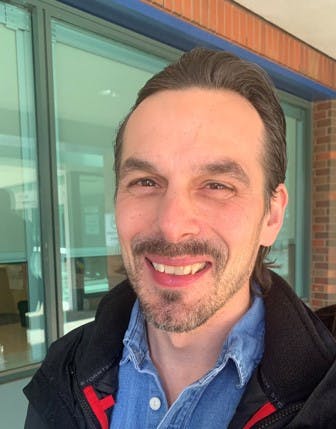
-
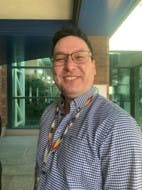
Email kienan.williams@ahs.ca -
Senior Project Manager SZ Indigenous Patient Navigator Project
AHS Indigenous Wellness Core
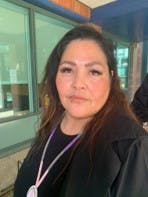
Email leslie.wells@ahs.ca -

Email kara.eaglebear@ahs.ca -
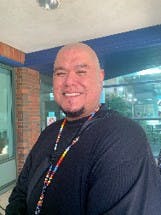
Email jeremy.chiefcalf@ahs.ca
Project Timeline
-
PRIHS Grant Awarded (Jan 2019)
Four Winds Initiative has finished this stage -
Grant Management & Project Set-Up (Jan - June 2019)
Four Winds Initiative has finished this stage -
Steering Committee Meeting and Project Naming/Pipe Ceremony (Aug 21, 2019)
Four Winds Initiative has finished this stage -
Develop Research and Evaluation Tools (Apr-Aug 2019)
Four Winds Initiative has finished this stage -
Stakeholder Engagement Session 1 (Sept 10, 2019)
Four Winds Initiative has finished this stage -
Working Groups Started (Jan 2020)
Four Winds Initiative has finished this stageWorking groups include:
- Connections and Communications
- Navigation
- Cultural Safety
-
Indigenous Patient Navigation Services Goes Live (Oct 2020)
Four Winds Initiative has finished this stage -
Pandemic hiatus (Mar 2020 - Mar 2022)
Four Winds Initiative has finished this stage -
Program relaunch (Apr 2022)
Four Winds Initiative has finished this stage- Hiring of Senior Project Manager (Apr 4, 2022)
- Relaunch of Steering Committee (June 2022)
-
Hiring of Indigenous Patient Navigators (Sept 2022)
Four Winds Initiative has finished this stage -
Indigenous Patient Navigator Services start (Oct 15, 2022)
Four Winds Initiative has finished this stage -
Indigenous Patient Navigator program goes live (Jan 10, 2023)
Four Winds Initiative is currently at this stage
Supporting Documents
-
 Indigenous Patient Navigation brochure _ April 2023 (449 KB) (pdf)
Indigenous Patient Navigation brochure _ April 2023 (449 KB) (pdf)
-
 Four Winds Overview Documents
Four Winds Overview Documents
-
 Publications and Media Mentions
Publications and Media Mentions
-
 AHS Media - Indigenous-led Patient Navigation services re-launched (Jan 2023)
AHS Media - Indigenous-led Patient Navigation services re-launched (Jan 2023)
-
 Lethbridge Herald - Indigenous-led Patient Navigation service re-launched (Jan 2023)
Lethbridge Herald - Indigenous-led Patient Navigation service re-launched (Jan 2023)
-
 Lethbridge News Now - New service to help Indigenous peoples in southern Alberta navigate health services (Jan 2023)
Lethbridge News Now - New service to help Indigenous peoples in southern Alberta navigate health services (Jan 2023)
-
 My Lethbridge Now - Indigenous support program returns to Lethbridge Hospital (Jan 2023)
My Lethbridge Now - Indigenous support program returns to Lethbridge Hospital (Jan 2023)
-
 Lethbridge Herald - Jan 2019 (149 KB) (pdf)
Lethbridge Herald - Jan 2019 (149 KB) (pdf)
-
 Lethbridge News Now - Jan 31, 2019 - New Research Hoping to Improve Health Outcomes for the Indigenous Population (888 KB) (pdf)
Lethbridge News Now - Jan 31, 2019 - New Research Hoping to Improve Health Outcomes for the Indigenous Population (888 KB) (pdf)
-
 AHS Media - Jan 31, 2019 - Research Aims to Improve Indigenous Health Outcomes (67.1 KB) (pdf)
AHS Media - Jan 31, 2019 - Research Aims to Improve Indigenous Health Outcomes (67.1 KB) (pdf)
-
 IPN Launch GlobeMail_1.jpg (113 KB) (jpg)
IPN Launch GlobeMail_1.jpg (113 KB) (jpg)
-
 IPN Launch GlobeMail_2.jpg (142 KB) (jpg)
IPN Launch GlobeMail_2.jpg (142 KB) (jpg)
-
 Lethbridge Herald - June 20, 2019 - PRIHS Launch Celebration (1.43 MB) (pdf)
Lethbridge Herald - June 20, 2019 - PRIHS Launch Celebration (1.43 MB) (pdf)
-
 ELT Notables - Nov 2019 (949 KB) (pdf)
ELT Notables - Nov 2019 (949 KB) (pdf)
-
 AHS South Zone Bulletin - November 2019 - Four Winds project steering committee zeroes in on solutions (2.01 MB) (pdf)
AHS South Zone Bulletin - November 2019 - Four Winds project steering committee zeroes in on solutions (2.01 MB) (pdf)
-
 2018/2019 Research and Innovation Annual Report - page 21 (2.98 MB) (pdf)
2018/2019 Research and Innovation Annual Report - page 21 (2.98 MB) (pdf)
-










